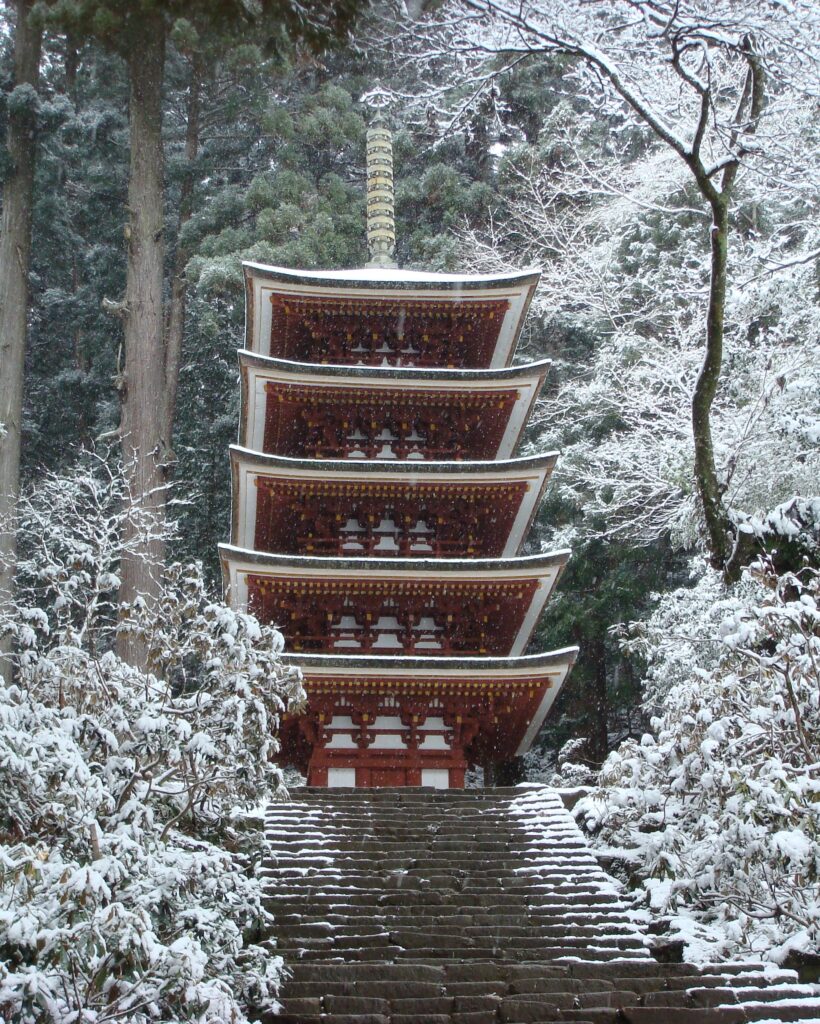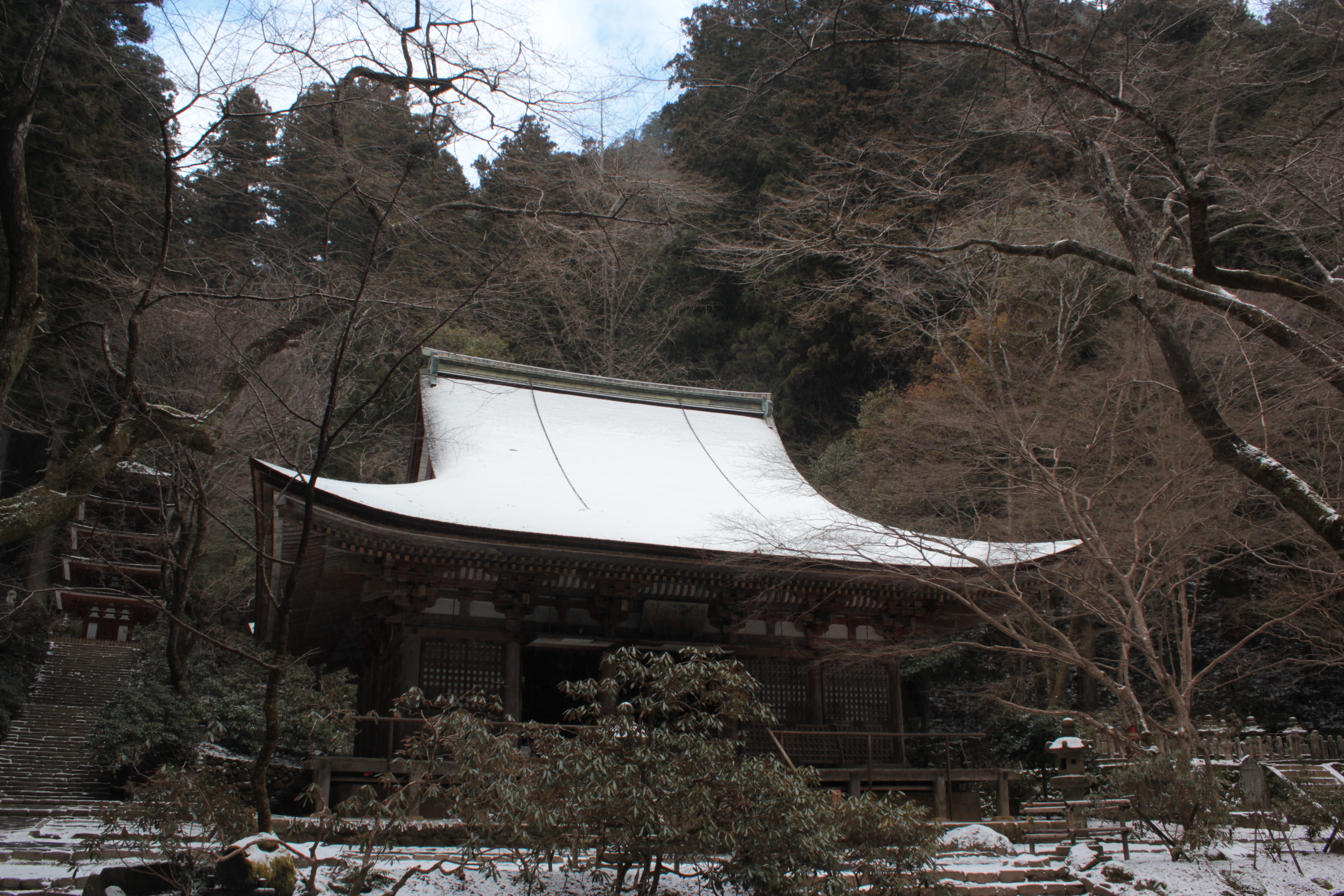This article was originally published in the December 2023 issue of CONNECT.
Rachel Adams (Nara)
 The clouds in Uda City, Nara Prefecture often resemble the scene Sei Shoganon described in the famous opening line of The Pillow Book: they wisp around the lush mountain tops, like steam or smoke, and elongate into what seem almost like dragons. The verdant, bushy mountains of Japan differ greatly from the purple mountain majesty I grew up with in Colorado, and even more so from the craggy brown ones I saw during my university days in Utah. But the biggest difference between Uda’s mountains and those in America is that the light fog covering the skyline may not actually be clouds, but instead, the sighs of a local dragon sleeping in the mountains.
The clouds in Uda City, Nara Prefecture often resemble the scene Sei Shoganon described in the famous opening line of The Pillow Book: they wisp around the lush mountain tops, like steam or smoke, and elongate into what seem almost like dragons. The verdant, bushy mountains of Japan differ greatly from the purple mountain majesty I grew up with in Colorado, and even more so from the craggy brown ones I saw during my university days in Utah. But the biggest difference between Uda’s mountains and those in America is that the light fog covering the skyline may not actually be clouds, but instead, the sighs of a local dragon sleeping in the mountains.
In many Asian cultures, dragons are associated with water, mountains, and healingーall of which Uda is famous for. The Kojiki (or Records of Ancient Matters, one of Japan’s notable texts about culture and folklore from the seventh century) designates Uda as a medicinal deer hunting ground. Deer antlers were ground into powder and their meat was believed to be used in place of nutritional supplements. This mountain town’s medicinal history continued into the 19th century when the town flourished under a medicine maker who eventually became an honorary samurai. Rivers run through all four of the villages that collectively make up Uda City, and each village has their own Shinto shrine dedicated to the dragon of Uda River. At these shrines, locals offer the dragon’s favorite food: beer and eggs. It’s also fitting that the biggest Shinto shrine along Uda River, Sumisaka Shrine, is recorded as the country’s first Shinto shrine consecrated for healing. Small local river dragons aside, the head honcho Dragon King(™) resides on Mount Muro and has several shrines and even a temple dedicated to it.
The Dragon King didn’t always live on Mount Muro though. According to a collection of legends written during the 12th century called the Kojidan, the Dragon King first lived in Nara City’s Sarusawa Pond. For those who have visited Nara before, it’s the pond right down the hill from Kofuku-ji and is next to the biggest tourist-trap Starbucks in Nara prefecture. After a court maiden, or uneme, yeeted herself into Sarusawa Pond following a one-night stand with the emperor during the eighth century, the Dragon King eventually moved to a different pond on Mount Kasuga, the mountain where Nara City’s Kasuga Taisha Shrine is. Ironically, there’s now a festival every September to appease the spirit of this poor uneme maiden, where a performer sings of her tragedy while riding on the back of a dragon boat. Back on Mount Kasuga though, some hooligans started dumping corpses in the Dragon King’s new pond, so it decided to permanently retire to the mountains deep in the province of old Yamato. The Dragon King now resides in the many caves on Mount Muro in Uda City, which is about an hour train ride away from Nara City. Although the caves are closed off to the public, you can still visit its many sites of worship, including Ryuketsu Shrine, Ryuchin Shrine, and the famous Muro-ji.
Muro-ji reflects a shift where architecture started to merge with nature instead of fighting against it.
Although Ryuketsu Shrine and Ryuchin Shrine are lovely and mystical, the pride of Uda City is Muro-ji, a historically beloved temple. I was fortunate enough to have come to Uda City during the peak of momiji season in 2021, and even more fortunate that my supervisor took me to Muro-ji to see the stunning fall foliage. I was already in quite a haze from my two-week quarantine in Tokyo, but it truly felt like I entered a fairytale as I wandered through the vermillion and gold grounds of this magical temple. Muro-ji was originally established by the founder of Shugendo, En no Gyoja. These may be unfamiliar names to many people outside Nara, but it’s a religion that was very prominent during the Nara period and, at the time, had the same amount of influence on Japanese culture as Shintoism and Buddhism. Many rites at Muro-ji prayed for rain and sought the healing powers of the Dragon King. The temple was later rebuilt as a Buddhist temple between 778 and 793 by Emperor Kanmu as a way to show gratitude for the healing he received at Muro-ji when he was younger.
 Muro-ji is also known as the “Mount Koya for women.” Mount Koya, the headquarters for Shingon Buddhism, didn’t allow the entry of women until 1872, but Mount Muro has always allowed women to worship on its grounds. It is believed that Kukai, the founder of Shingon Buddhism, buried treasures on Mount Muro, and Muro-ji’s treasure hall holds many relics depicting Kukai’s visits to the mountain. It’s a small collection, but when I visited, I couldn’t believe how cool the Buddha statues were. In particular, I think many enthusiasts and art historians would be interested in the Shaka Nyorai statue, which was carved from a single piece of wood. Its draping cinnabar robes truly showcase the craftsmanship of the early Heian period (794-1185). It was also fun seeing Kukai depicted in scrolls with the famous local dragons of my city.
Muro-ji is also known as the “Mount Koya for women.” Mount Koya, the headquarters for Shingon Buddhism, didn’t allow the entry of women until 1872, but Mount Muro has always allowed women to worship on its grounds. It is believed that Kukai, the founder of Shingon Buddhism, buried treasures on Mount Muro, and Muro-ji’s treasure hall holds many relics depicting Kukai’s visits to the mountain. It’s a small collection, but when I visited, I couldn’t believe how cool the Buddha statues were. In particular, I think many enthusiasts and art historians would be interested in the Shaka Nyorai statue, which was carved from a single piece of wood. Its draping cinnabar robes truly showcase the craftsmanship of the early Heian period (794-1185). It was also fun seeing Kukai depicted in scrolls with the famous local dragons of my city.
Aside from the treasure hall, Muro-ji is also notable for its Golden Hall and five-storied pagoda. These are the only two buildings in all of Japan that are left standing from the early Heian period. As the only two remaining buildings from the early Heian period, they teach us a lot about shifts in Japanese architecture from when the capital of Japan was transitioning from Nara to Kyoto. Much architecture during the Nara period had a flat layout: hills were leveled and land was raised so all buildings were on equal ground. However, Muro-ji reflects a shift where architecture started to merge with nature instead of fighting against it. The layout of the buildings at Muro-ji follows the layout of the mountain, much like earlier Shinto architecture did. Also, the five-storied pagoda is the smallest pagoda in Japan, so I think it’s fair to say that it’s also the cutest pagoda in Japan.
No matter what season you decide to visit, Mount Muro and Muro-ji are a side of Japan that’s hard to find in bustling cities like Tokyo and Osaka. The mountain and temple are just as captivating in the winter when the mountain is shrouded in snow and silence. It’s thrilling to be able to experience what Japan may have sounded like over a thousand years ago. During the autumn and New Year seasons, they have light-up events where lanterns line the temple grounds and a projection mapping of a dragon slinks up Muro-ji’s five-storied pagoda. However, even if you don’t find a dragon during your visit, I’m sure you’ll be able to still feel its healing power as you watch the misty clouds dance over the mountains deep in the province of old Yamato.
Source List
- Japanese Culture by Paul Varley
- In Search of the Dragon: Mt. Muro’s Sacred Topography by Sherry Fowler (for more information specifically about the gender of the dragon please see pp.155-156)
- Nara Manyou no Tabi Hyakushu by the Nara Mahoroba Somalier Association and Makoto Ueno
- Murouji Temple
Rachel Adams is a third-year U.S. JET in Uda City, Nara. By day, she enjoys classical literature and Japanese history rabbit holes. By night, she can be found at karaoke, translating music, or simping at concerts. She is also head editor of the Nara AJET newsletter.




